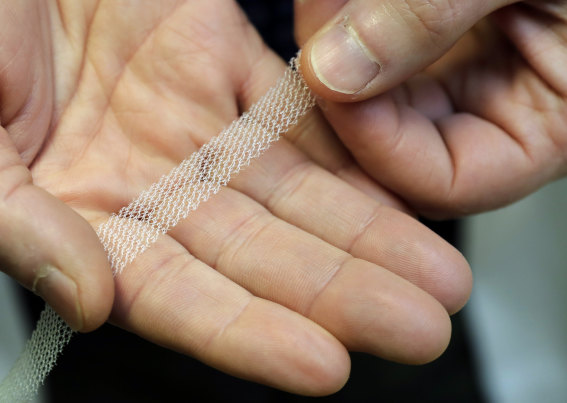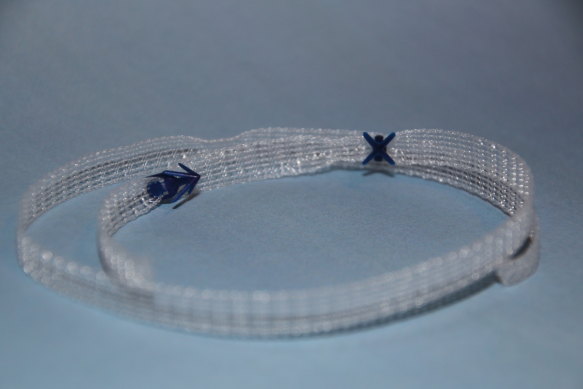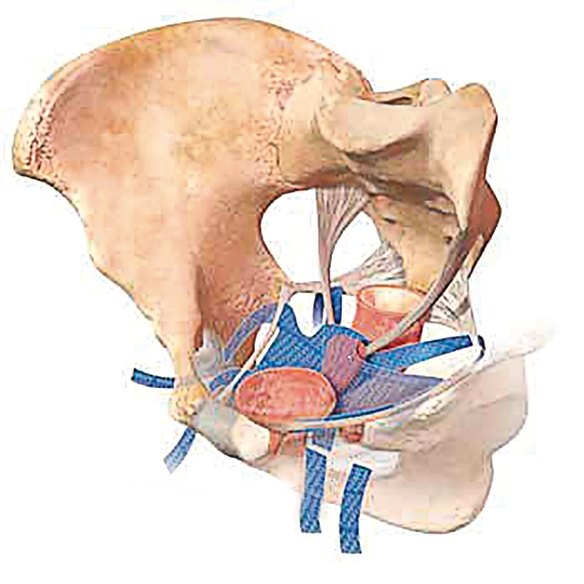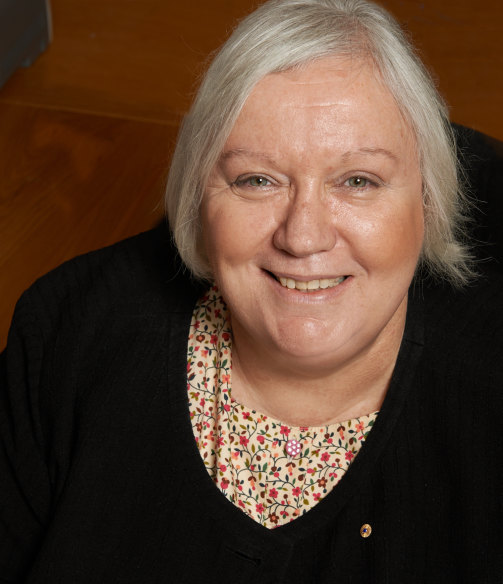This was published 6 years ago
The 'eight-minute' cure: how transvaginal mesh sentenced thousands of women to a life of pain
Up to 18,000 Australian women have suffered mild to horrific complications from the insertion of transvaginal mesh devices. How did the health system let them down so badly?
By Amanda Hooton and Joanne McCarthy

Grace Irvine's mesh surgery means that now, walking any more than short distance feels "like a cheese grater in my vagina."Credit: Kristoffer Paulsen
Grace Irvine has blue eyes, pale skin, and short hair that fluffs up at the back like a baby chick's. She is 29 years old. Three years ago, she was a healthy mother of three boys living in a small town in Victoria. She worked as a dental assistant, and wanted to study nursing.
After her second son, Sammy, was born in 2013, Irvine noticed what felt like an uncomfortable lump in her vagina when she sat down. This is a common symptom of pelvic organ prolapse (POP), a condition that, at some point, affects about half of all women who've had children. It happens when organs of the pelvis – bladder, rectum, uterus – drop or press into the vagina. She also noticed "a bit of leakage" during exercise, caused by stress urinary incontinence (SUI). This is a separate condition to prolapse, but both are socially disabling – and cause serious health problems if very severe – and Irvine was only 24.
"I didn't want to be wearing nappies for the rest of my life," she explains, smiling. "I did want to get it fixed."
In June 2016, when her third son, Parker, was six months old, she had an operation at her small local hospital, performed by two gynaecologists with an "interest" in mesh surgery, to insert transvaginal mesh. She was told the operation would cure her incontinence and prolapse, and that her recovery would be swift and easy – two weeks at most.
None of this proved true. She woke from the operation in agony, and six weeks later, her vaginal cuff and bladder were both prolapsing, and she was still incontinent. "The surgeon was shocked," recalls Irvine. "He sent me back to the referring specialist." "It's a pretty rough job," he told her. "But it's not the worst I've seen.'"
Irvine lives in a modest brick and tile house. She walks slowly, favouring her right leg, and often pauses while speaking, breathing through her nose. Sitting at the kitchen table, even though she's on a cushion, she shifts around a lot, arms folded tightly. Three years after her initial operation, she's now almost entirely incontinent: at her cousin's wedding recently, she wet herself "completely: a full bladder. I was wearing a proper urinary pad, but it was dripping down my leg." She has frequent serious infections and discharge; and she's been unable to have sex with her partner of 12 years for more than a year because it's too painful.
This pain is the worst thing of all, she says. She's not on any painkillers, because she's worried about dependency, and she can't sit for long, or walk far, because it feels "like a cheese grater in my vagina" – an analogy used by many mesh patients – "like rough surfaces are catching and rubbing together". She can't work, or walk to the local park with her kids, or exercise her border collie; she needs a wheelchair for long outings. The other night, her oldest son, Tyler, now 10, said to her: "'I miss doing things with you, Mum.' " Irvine looks down at the kitchen table. For the only time during a three-hour interview, her self-control slips. "My kids are paying the price for this," she says, eyes filled with tears. "I just can't believe it. I can't believe this happened to me."

A sample of transvaginal mesh. In Australia, only 13 mesh products from more than 100 now remain on the market. Credit: AP
Since its introduction in the late 1980s, somewhere between 7000 and 18,000 women have experienced complications from mesh surgery in this country. This figure echoes as many as 200,000 cases reported overseas. In what one surgeon has called a "tragic, two-decade-long free-for-all", these women were victims of often poorly trained doctors, using devices that, in many cases, lacked scientific evidence of safety or effectiveness, without being properly informed of what was being done to them.
In this country, most mesh surgery training was facilitated by mesh manufacturers themselves (with all the potential for conflict of interest this creates); the Therapeutic Goods Administration (TGA) required no independent clinical evidence about many of the transvaginal prolapse mesh devices it cleared; and according to a 2017 survey of 1900 women by the Health Issues Centre, a Victorian health consumer peak body, more than 60 per cent of women did not give informed consent. Instead, when things went wrong, these women were cut loose by doctors, regulators and manufacturers alike. Their reports of serious complications and debilitating pain were ignored; the products they were implanted with were not investigated; and their doctors told them they were "imagining the pain", that they should "try anal sex", or that they were "crazy".
According to former federal senator Derryn Hinch, who agitated for a Senate inquiry into mesh use, this is all par for the course.
"I remember sending some mesh-related paperwork to a government administrative office," he recalls. "And when it came back they'd changed the word 'vaginal' to 'pelvic'! That's what's f...ing wrong with all this! For five years, no one's touched this because it's got the word 'vagina' in it. If this had been a male problem, it would have been up there and out there and fixed in six months!"
The eventual 2018 Senate inquiry recommended a national audit of past mesh procedures and a registry for future ones; mandatory reporting of problems by doctors; and the establishment of specialist multi-disciplinary mesh clinics. It also exposed at least some of what mesh-injured women were dealing with. A young teacher testified about trying to look after a class of little children while wearing a catheter bag strapped to her leg after she was left incontinent; a mother of five described how mesh severed her urethra (the tube that carries urine) and destroyed her vaginal wall; a registered nurse explained that her mesh infections produced such a "putrid-smelling discharge" that even showering twice daily couldn't contain it. Many women confessed they had considered suicide.
Professor Thierry Vancaillie, a gynaecologist and pain specialist at the Women's Health and Research Institute of Australia, testified that "[these women] are unable to sit for any length of time, which means they can't enjoy such basic social interaction as a family dinner. They can't have intercourse. They have difficulty emptying their bladder or bowel. They have difficulty with basic physical activity, such as walking or going up flights of stairs. [For women with serious complications, it is] a true disaster."
A disaster the medical profession has been collectively apologising for. "It was a long way from our proudest hour," then-Australian Medical Association president Michael Gannon told Fairfax Media in 2017. "To call [our support of mesh products] a tragedy is not overstating it at all."
"I'd like to offer an apology," said Dr Steve Robson, then-president of the Royal Australian and New Zealand College of Obstetricians and Gynaecologists (RANZCOG). "A personal apology and an apology on behalf of the College." Even Greg Hunt, the federal Health Minister, acknowledged in October last year "all of those women with the historic agony and pain that has come from mesh implantation, which has led to horrific outcomes. On behalf of the Australian government, I say sorry."
Unsurprisingly, many women have decided all these officials can take their apologies and, as one mesh patient put it, "stuff them". These women are now seeking financial compensation. One of the largest medical class actions in Australian history, by more than 1300 women against Johnson & Johnson and Ethicon (manufacturers of mesh products), is currently awaiting judgment in Sydney's Federal Court. A second case, by 850 women against American Medical Systems (also a manufacturer) was filed last July. There has also been an unknown number of individual settlements against Australian doctors.
Overseas, meanwhile, the British Medical Journal reported in 2017 that more than 1000 British women had brought legal cases involving mesh to court. In Canada, more than 3000 transvaginal mesh cases had been filed by the end of 2018, and some 107,000 are outstanding in the US, making it one of the largest mass torts on record. More than $US7 billion has been awarded, and in the next few years – according to some estimates – global compensation claims for mesh complications could exceed $20 billion.
Transvaginal mesh looks set, by some measures, to become one of the biggest issues in women's health for decades. Hinch calls it the biggest issue "since thalidomide". But is anything actually changing? Beyond the verbal mea culpas and the fight for compensation, what lessons have we learnt about protecting women – protecting all of us – from these kinds of surgical interventions? And what has anyone actually done to help Grace Irvine, and the thousands of women like her?

Former senator Derryn Hinch.Credit: Andrew Meares
"Transvaginal mesh" is the catch-all term for any product surgically inserted via the vagina to support the pelvic organs. Doctors embraced the new mesh devices because they were marketed as offering swifter surgery, quicker recovery times and lower failure rates than the traditional "native tissue" treatment, in which women's own tissue is used for support. Sometimes the mesh takes the form of "slings" or "hammocks"; sometimes it's called "tape" that wraps around or beneath organs. It's usually made of polypropylene, but has also been constructed from materials such as nylon and porcine submucosa, a technical term for pigs' guts.
Importantly, out of 100,000-odd (and perhaps as many as 150,000) women treated in Australia, most have not reported complications from mesh surgery – indeed, it's been very successful for many. Success has been most noticeable with stress urinary incontinence, treated via mid-urethral slings (MUS). Many MUS devices have a great deal of scientific evidence behind them, and they remain – despite complications – the international gold-standard treatment.
But for a substantial minority of women, the experience has been not just bad, but truly horrid. Most complications involve the mesh itself, which hardens and shrinks inside the body, perforating tissue and sometimes piercing other organs. In the bladder or bowel, this can lead to adhesions, infections, fistulas, abscesses and severe urinary and defecation problems. In the vagina, mesh may poke into the vaginal passage itself. Male partners can feel this mesh with their penises during sex; women can feel it themselves with their fingers. Unsurprisingly, many women with mesh problems, like Grace Irvine, find sexual intercourse extremely painful. According to the Health Issues Centre survey, as many as 25 per cent of relationships break down following mesh complications.
Professor Helen O'Connell is one of Australia's top functional and female urology surgeons, and a former director of the Royal Australasian College of Surgeons. Her career has neatly spanned the decades during which mesh was extensively used – but she has always avoided it, relying instead on native tissue repairs. While diplomatically maintaining that it's "a really complex area", she says that "in almost every circumstance, there's an option" between using mesh and doing native tissue repair. "I'm not saying there's no place for [mesh], but my need for it has become extremely limited." What is required for successful native tissue repair, she says, crediting her practice colleagues, "is really high-quality surgery, performed with a really high level of expertise".
What's become clearer and clearer as more and more women have come forward with horror stories is that this expertise has been, for many, woefully lacking.

Leesa Tolhurst, left, with her mother Alison Blake, who took her own life because of the pain of an unsuccessful transvaginal mesh procedure. Credit: Courtesy of Leesa Tolhurst
When retired primary school teacher Alison Blake was 62, she was referred to Sydney surgeon Dr Richard Reid for her pelvic and prolapse problems, for which she'd already had unsuccessful surgery. According to her only child Leesa Tolhurst, before surgery her issues "weren't overly severe. She did feel uncomfortable, but she had full function. She just needed to go to the toilet regularly." Reid operated on Blake – a daily ocean swimmer who took pride in her health and appearance – in February 2014. She suffered immediate complications, including severe and continuous pain. She returned to Reid, who operated twice more before the end of the month. After this surgery, Blake was left with no bladder function whatsoever. "She was completely reliant on self-catheterising," explains Tolhurst. "She had to plan everywhere she went, because she knew she had two hours at most before she'd have to lie down somewhere [to do that]." She was unable to attend her own father's funeral because the crematorium had no facilities for it. "It completely stole her dignity," says Tolhurst.
Before her treatment, Blake presumed – as most people do of their doctors, especially their specialists – that Reid knew what he was doing. In this she was tragically mistaken. Reid had, in fact, been suspended and fined in the US (where he lived for nearly two decades) in 1998, after a disciplinary hearing following complaints by three women. One of these, a 23-year-old, was awarded $US7.6 million after a civil court heard that Reid's surgery had left her unable to "ever have sex again".
On his return to Australia, Reid was permitted to practise again (prior to a change in legislation requiring doctors to record suspensions). But his incompetence led to restrictions being placed on his practice in 2011. In 2018 (after he retired), he was found guilty of professional misconduct after 17 women were left with serious injuries following mesh surgery by him.
The mesh Reid used in his treatment of Blake, like all transvaginal meshes, was designed for tissue to grow around and through it, "like passionfruit over the chicken coop", as Hinch puts it. This makes its removal extremely difficult, even for highly skilled surgeons. Reid's attempts on Blake left "little spikes of it inside her", says Tolhurst. "On certain movements she'd still feel it digging into her."
She wanted to continue her life so much, but she’d just lost all her hope.
Leesa Tolhurst, daughter of Alison Blake who took her own life in 2015.
This continual pain, plus the daily humiliation and social isolation caused by her incontinence, eventually overwhelmed Blake. "I cannot bear the thought of leaving you but the emotional torment and physical pain I'm going through are just too much," she wrote in a note to Tolhurst. "I simply cannot bear to be lying on a couch for months on end and to have to rely on catheters, enemas, Temazepam, painkillers and be a burden to my family and friends."
In June 2015, Blake took her own life.
"I miss her every day," says Tolhurst, her voice choked. "She wanted to continue her life so much, but she'd just lost all her hope, after hanging on for so long."
Alison Blake's case illustrates one of the biggest issues with mesh: medical skill and responsibility. Reid was clearly unfit to be operating when Blake encountered him in 2014. And mesh brought vulnerable patients into contact with doctors working in an extraordinarily laissez-faire, oversight-free arena. As one senior obstetrician gynaecologist explained to Good Weekend, "the mesh reps, the device reps, whoever, come and sit in your office and say, 'So this is the device – it's fantastic, we can give you free kits, we can show you how to use it.' And you go, 'Okay, well, I've got a list on Monday, why don't I try it out.' And that's your training."
Such an environment places enormous responsibility on individual doctors to oversee themselves. And too often, in mesh cases, this self-monitoring fell short. "We got really excited, and we weren't cautious enough – there's no question of that," Dr Jennifer King, then chair of the Urogynaecological Society of Australasia, told the Senate inquiry. "[Mesh] got used overenthusiastically." One anaesthetist who's worked with several mesh surgeons (not including King), believes it went beyond mere enthusiasm. "As a group, they display a lot of narcissistic, god-complex personality traits," he says. "You could argue that surgeons as a whole tend towards narcissism, but these guys were something else. They were absolutely convinced they were wonderful surgeons, and that everything they did was right, and that no one should question them. They thought they were God's gift, basically."

Grace Irvine, now 29, can't work, walk to the local park with her kids, or exercise her border collie; she needs a wheelchair for long outings. Credit: Photograph by Kristoffer Paulsen. Hair and make-up by Karen Burton.
Grace Irvine has had to grapple with the fact that, in addition to the failure of the surgery itself, she was also subjected to a hysterectomy while under anaesthetic. "They mentioned [a hysterectomy] as a really unlikely possibility in one conversation," she recalls. "They were like, 'We'll just put it down [on the consent form], but we're sure we won't have to do it.' I mean, I had to go and buy a Mirena coil [an IUD] before surgery: they were going to insert it for me. Then I wake up, beside myself with pain, and this has happened." Her surgeons told her they'd removed her uterus because her uterine prolapse was "worse than they thought". As a further blow, Irvine's hospital bed after surgery was in the maternity ward of the hospital; she could hear newborn babies in the rooms on either side. "It was absolutely devastating," she says.
There are many stories like hers: women – including many young women – whose sexual and reproductive organs were irreparably damaged. Reid, as it turns out, worked with another controversial mesh surgeon, Dr Peter Petros, who was involved in the early development of incontinence mesh in Western Australia. Petros came to the attention of the courts as far back as 2004, when a WA district court judge awarded a woman more than $136,000 after evidence of her severe and permanent injuries following mesh surgery by him.
Since then, a series of complaints culminated last month in a professional misconduct hearing brought by the NSW Health Care Complaints Commission (HCCC), in which Petros was found to have acted improperly and unethically and misled the Commission. Had he not already retired, he would have been struck off over several issues, including failing to disclose his financial interest in a mesh device, the Tissue Fixation System (TFS), which he developed and promoted for many years.

A Tissue Fixation System device, no longer on the market.
The HCCC launched its investigation after a woman left with serious and permanent injuries as a result of being implanted with Petros's device by Reid, without her knowledge or consent, complained Petros had failed to disclose to her his financial interest in the device. Petros was also present, supervising Reid, when Reid implanted Petros's TFS device on a second woman, during which Reid cut an artery, resulting in a near fatal incident. The woman required 12 units of blood and transfer to a major public hospital. The tribunal found Petros wrote an improper and inaccurate report about that event, in which he sought "to minimise the course of the surgery and the nature of the complications suffered by the patient".
Most surgeons are skilled, careful, and trying to act in their patients' best interests. But, as illustrated by recent court cases, when it came to mesh, doctors, manufacturers, and private hospitals (in which many mesh procedures occurred) all stood to make large – one might argue compromisingly large – amounts of money.
During the Johnson & Johnson class action in Sydney, one of the company's advertising concepts for transvaginal mesh products was tendered to the court. It was an ad aimed at doctors, and in it, two surgeons boast about their successful mesh practices. "Just got back from a week in St. Moritz," says one. "Fabulous ski conditions, beautiful resort." He's just picked up his new Lamborghini. But now he's got to rush – he's got to squeeze more mesh patients into his schedule. "You know I can do a TVT-O [an incontinence mesh procedure] in eight minutes."

Professor Helen O’Connell.Credit: Kristoffer Paulsen
Obviously, these aren't real surgeons. But Professor O'Connell "can definitely remember people talking about the time it was taking for them to do a mesh sling. And because people could do it very quickly, potentially that could lead to a position where people would say, 'This is child's play. It's so easy ...' " She pauses. "And, well, it possibly isn't that easy. You may not have as many steps as a heart transplant, but the patient is going to have that mesh there permanently. And if you're not giving it full respect, that could potentially be a problem."
In the aftermath of the mesh debacle, many doctors have suggested that it was the device manufacturers – such as Johnson & Johnson – who were to blame for the problems. And if it wasn't the device manufacturers, it was the TGA, which cleared them for use in the first place. The current president of RANZCOG disagrees. "We as a medical profession have to accept responsibility," says Dr Vijay Roach. "We can't just duck it and blame everybody else."
He acknowledges that the profession itself may need more oversight, more restrictions, more rules about behaviour and training. "I have no problem with any of that," he says. "I mean, as a specialist doctor, I currently have virtually no regulations governing my working hours, alcohol intake, fee structures. Contrast that to other professionals who are responsible for people's lives." Pilots, train drivers, even forklift operators are subject to shift limits and blood alcohol tests; senior doctors, in particular, have no such requirements. "But the difficulty," says Roach, "is in deciding who regulates it. If you believe – and I do – that the college is in the best position to regulate doctors and the introduction of new techniques and devices, then the colleges have to be adequately resourced. And we are not."
In the meantime, the Australian Commission on Safety and Quality in Health Care (ACSQHC) has moved to protect patients. Late last year, credentialling procedures for mesh surgeons were accepted by every state and territory, and are currently being implemented by hospitals. According to ACSQHC chief executive, Adjunct Professor Debora Picone, "this guarantees that only the most highly qualified urogynaecologists, gynaecologists and urologists can now undertake mesh surgery. Uncredentialled surgeons are not permitted to undertake that surgery."
The problem is that this measure, while positive, is limited in scope. What about the next group of patients being offered new treatments, by doctors without rigorous training, using unproven devices? Describing his own practice, Roach recalls a recent visit from a pair of sales reps with a new laser machine that, they're claiming, will "rejuvenate the vagina" – a claim without scientific evidence. "They came in and said, 'We'll get you the equipment, and you're going to be earning $100,000 a month on it'," he recalls. "Just crazy money." As Roach puts it, "the doctor starts by being sucked in to buying this extremely expensive device, and then, because of that financial investment, convinces themselves they're doing the right thing by the patient, when they're not. The doctor is totally conflicted, and the patient never has a chance."
Why weren't mesh devices properly investigated 20 years ago, long before surgeons ever got hold of them? How did they ever reach a hospital shelf, let alone a patient's body?
The gatekeeper for the Australian medical market is the TGA. Most people believe the TGA's remit from government is to subject every new drug and medical device to stringent review, to ensure that the scientific evidence supporting its safety and effectiveness is absolutely robust.
This sounds straightforward. But in the case of mesh, it was not. For some products – primarily the MUS products used for incontinence – there is extensive research supporting their use. As the 2017 Cochrane Review of mesh studies (a highly respected report by international experts) states, these slings "have a good safety profile" though the experts noted the need for "longer-term data from the numerous existing trials" to help resolve "uncertainties about long-term effectiveness and adverse event profiles".
Transvaginal prolapse mesh devices, however, have no such proof. The 2016 Cochrane Review of transvaginal mesh used in prolapse found that the international body of evidence about these devices was of "very low to moderate quality". In many cases, it was simply non-existent, and where present, its limitations included "poor reporting of study methods, inconsistency, and imprecision". As of 2015, what evidence did exist failed to prove safety or efficacy. Indeed, said the Cochrane experts, "the risk-benefit profile means that transvaginal mesh [for prolapse] has limited utility in primary surgery".
And yet between the years of 1998 and 2013, the TGA cleared more than 100 different mesh products for implantation in women's bodies, including many of these highly problematic transvaginal prolapse devices.
Today, the head of the TGA, Dr John Skerritt, lays responsibility for the original clearances on the American Food and Drug Administration (FDA). "At that time, the TGA accepted approvals from different jurisdictions, including Europe and the US FDA, and used these approvals as the basis for [clearance in Australia]," he says.

An illustration of how one mesh device, the Prolift, was used.
This matters because in 2001, the FDA cleared a transvaginal mesh device called the IVS tunneller. And significantly, this device was green-lighted not only for incontinence, but also for prolapse. The FDA made this decision on the basis of "substantial equivalence" – that the IVS tunneller was so similar to a device already on the market (in this case, the TVT incontinence sling) that it needed no new or independent clinical proof that it worked, and was safe. This clearance, fatally, meant that the IVS tunneller could be used not just for incontinence, but also for prolapse – despite the lack of specific evidence that it was either safe or effective for prolapse use.
"It's almost impossible to believe that that [FDA] clearance happened," says Professor Chris Maher, one of Australia's top urogynaecologists and a lead Cochrane Review author. Prolapse and incontinence are different conditions involving different anatomical structures. Also, the IVS tunneller was made of a different material from the TVT, and was of a different design. "The clearance was factually incorrect," says Maher. "There was no substantial equivalence."
And yet, in the years to come, this single clearance opened the door for a cascade of new prolapse devices to be approved, first overseas and then in Australia. So in terms of the science behind them, a whole section of the mesh market was simply a castle in the air.
Many doctors were as shocked as their patients to discover that the mesh devices they were implanting were not supported by watertight scientific evidence. As of January 2018, all transvaginal mesh prolapse devices have been removed from the Australian market, and, as of last month, only 13 mesh products remain, including some prolapse devices that cannot be inserted transvaginally, and the Johnson & Johnson TVT mesh mid-urethral sling for incontinence. All of them, says Skerritt, are now classified as high-risk (class III), "which [require] extensive analysis of clinical and non-clinical evidence" before clearance.
Most doctors think this reclassification is a good move, as is the establishment of a national Pelvic Floor Surgery Clinical Quality Registry, which was announced by Health Minister Greg Hunt in April. "What we want," says Helen O'Connell, "is a very well-tested group of products, about which we have a great deal of long-term data, being used by a group of highly competent surgeons."
Women with existing mesh complications are glad others will be protected in future. "I want no woman to suffer as I have suffered," testified one woman at the Senate inquiry. But because they already have now-banned products in their bodies, future restrictions won't help them – and might isolate them further as the lack of new cases makes their suffering seem increasingly irrelevant. So if you're one of these women, what do you do now?
Grace Irvine, for one, isn't quite sure. She's considering her legal options: she's part of the Johnson & Johnson case, and may yet take legal action against her own doctors. She had her mesh removed at Melbourne's Royal Women's Hospital last August. According to her operation notes, her mesh was "exposed one centimetre under urethral meatus" – where urine is discharged from the body. It was also "very adherent to periosteum and required division at pubic bone to facilitate removal". In other words, mesh was stuck to the tissue covering her pubic bone, which had to then be pulled apart – which she describes as "a bit like having your hip surgically broken" – and the mesh shaved away from the tissue to get it out. In the course of the operation, the obturator nerves of her right leg were damaged, which is why she limps.
She has a large scab on her right shin, I notice during my visit. "Oh yes," she says sheepishly.
"I've got no feeling below the knee, so I'm always banging it on things." Her new surgeon, in whom she has great – and under the circumstances, extremely touching – faith, has told her she will need "several more surgeries". Specialists at The Royal Women's Hospital have also told her that her hysterectomy was unnecessary.
Mesh removal complications aren't unusual. Professors O'Connell and Maher both do removal operations, and both regard them as extremely difficult, often distressing procedures. "It's bloody horrible surgery," Dr Jennifer King told the Senate inquiry. Indeed, in many cases, even the most experienced surgeons are reluctant to remove mesh, because of the risks of causing new injuries, or exacerbating old ones. And yet, says Maher, more and more women are anxious about potential problems and seeking full removal. "And because they're so adamant, increasingly it is being performed," he explains. "In a way, doctors' opinions have been sidelined."
Mesh removal is a matter of opinion. Some women want it, whatever the risks. "They feel violated," says Hinch. "And I can totally understand that. They just want it gone." Others feel Australian surgeons can't be trusted, and want to travel overseas, where complete mesh removal costs tens of thousands of dollars and results are mixed.
According to RANZCOG's submission to the Senate inquiry, removal surgery is entirely possible in Australia, though it may require a surgical team with "urogynaecologist/gynaecologist and urologist and/or colorectal surgeon" expertise, and surgery can take eight hours or longer. A multi-disciplinary team and all-day surgery, to remove a product that took one person as little as eight minutes to put in.
And even when such surgery is successful, the problems aren't over. "Unfortunately, pain may persist in as many as 50 per cent of women," says Maher. You may remove all the mesh, repair all the damage, and yet the experience of terrible pain remains. How can this be so?
If this had been a male problem, it would have been up there and out there and fixed in six months!
Former senator Derryn Hinch
Dr Jason Chow is an obstetrician/gynaecologist in Sydney. He's also a pain specialist, and every week he sees patients with chronic pain from mesh complications. Chronic pain, he explains, is the result of a complex sensitisation process within the body. "[It's] a kind of maladaptive response from the nerves that report pain. It's a change in the pathways," he says. "The pathways that tell you you've stepped on a thumbtack and you're feeling pain are not the same as the pathways telling you you're still feeling the thumbtack three months down the track."

Professor Debora Picone.
The problem is that most non-pain-specialist doctors don't understand chronic pain. For this reason, the Senate inquiry specifically recommended that the multi-disciplinary medical units for the treatment of mesh patients should include pain specialists. "That's crucial," says ACSQHC's Debora Picone. "These women have major issues with pain management, major issues of good old-fashioned psychological trauma, particularly in the old days when they weren't believed. The question is, how long it will take to get the centres going?
"I've been in health a long time," she adds. "And to be honest, it's not going to happen overnight – not even within 12 months. This is a new clinical problem, and it's a long process. But I'm confident it will happen."
Some things have improved for patients with transvaginal mesh complications in Australia. Better awareness among health professionals helps, as will the mesh registry, multi-disciplinary centres and better accreditation of doctors. And the removal of unproven mesh devices from the market, plus information about informed consent, which hospitals must now provide to patients, will help protect women in the future.

Dr Vijay Roach.Credit: Steven Siewert
But not all the signs are good. Last year, Maher – who first raised the alarm on mesh more than 20 years ago – experienced a terrifying groundhog day. In last November's edition of the respected Medical Journal of Australia, he and colleague Dr Melissa Buttini expressed the widespread concern of doctors about a new wave of CO2 laser treatments marketed at women for "vaginal rejuvenation". (These are the lasers represented by the reps who visited RANZCOG's president Dr Vijay Roach, suggesting he could make $100,000 a month from treatments.) In August, the US FDA issued a warning about laser devices in this context. (The TGA is currently reviewing their use.) "These products have serious risks and don't have adequate evidence to support their use for these purposes," the FDA stated. "We are deeply concerned women are being harmed."
Maher and Buttini are also concerned. They point out the "lack of properly controlled trials", the "deceptive health claims and significant risks", and the fact that companies "promoting vaginal laser treatment do not currently need to provide evidence from stringently conducted trials in order to receive device clearance [from the TGA]".
Sound familiar? "It's exactly the same," says Maher. Unproven devices, patients at risk. "Doctors do want to do the best for their patients," he says. "But sometimes they get carried away with their enthusiasm for the newest, most innovative treatments. Women need to know that, if treatments aren't funded by Medicare, they may not have been fully assessed for safety or effectiveness."
In the wake of what's gone before, he concludes, doctors and patients alike need to be extremely careful. "Have we got the message from mesh? I'm not sure we have."
Lifeline 131 114
To read more from Good Weekend magazine, visit our page at The Sydney Morning Herald, The Age and Brisbane Times.